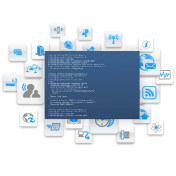NetCmdlets - Server License
- Brand: /nsoftware
- Product Code: NetCmdlets - Server License
- Availability: In Stock

Internet Communications
NetCmdlets extend the features of Microsoft Windows PowerShell with a broad range of network management and messaging capabilities. The current release contains dozens of Cmdlets providing access to network and host protocols such as SNMP, LDAP, DNS, Syslog, HTTP, WebDAV, FTP, SMTP, POP, IMAP, Rexec/RShell, Telnet, and more.
Cmdlets Included
- Certificate
- Cloud Storage
- Data
- DNS
- FTP
- HTTP
- IM
- IMAP
- LDAP
- MX
- NNTP
- Packet
- Page
- Ping
- POP
- PowerShell Server
- RAS
- Rexec
- Rshell
- RSS
- S3
- SFTP
- SMS
- SNMP
- SSH
- Syslog
- TCP
- Telnet
- TTP
- Time
- Trace
- Trap
- UDP
- VPN
- WebDAV
- Whois
- ZIP
Please see the documentation for a complete list of cmdlets and their details.

Manage Network Devices
NetCmdlets is a comprehensive framework of PowerShell cmdlets for monitoring and managing network devices through standard Internet protocols. With NetCmdlets and Windows PowerShell, admins can easily script common network management tasks including router configuration, switch port monitoring, directory access, VLAN administration, remote execution, and more!
Control Routers, Switches, and Other Devices via SNMP
The easy-to-use get-snmp and set-snmp Cmdlets make working with SNMP capable devices straightforward and intuitive. Administrators can easily automate and script processes for monitoring bandwidth, throughput, up-time, or any number of other network management capabilities.

NetCmdlets gives administrators a powerful set of tools for scripting and automating common network management tasks. For example, finding all of the manageable SNMP agents on a network is as simple as importing the NetCmdlets library and calling get-snmp with a broadcast address:
param( [string] $ipaddress = "255.255.255.255" )
if(!(Get-Module | Where {$_.Name -eq "NetCmdlets"})) {
Import-Module "NetCmdlets"
}
get-snmp -agent $ipaddress -oid sysName.0

Manage Linux, MacOS, and Unix from Windows
NetCmdlets gives administrators the ability to connect PowerShell scripts to remote Linux/Unix/MacOS systems, and execute commands remotely using standard networking protocols like SSH, Rexec, RShell, Telnet, and more! Through straightforward and easy-to-use cmdlets it is possible to securely automate and orchestrate remote systems from Windows.
Invoke-SSH
For secure shell connections, NetCmdlets provides the Invoke-SSH cmdlet. Below is an example of connecting to a remote SSH server to execute the “ls” command.
PS> invoke-ssh -server myserver -user myuser -password mypassword -command ls Do you want to trust the certificate presented? The server has presented the key below. Fingerprint: 59:52:C8:DB:C8:3A:FE:CF:9D:02:E3:31:3A:2C:11:E4 [Y] Yes [N] No [S] Suspend [?] Help (default is "Y"): y Text EOL ---- --- AssemblyInfo.vb True Documents True EmptyFolder True Lance True test.exe True test.ps1 True test.txt True v6tests True v8tests True
Invoke-Rexec and Invoke-Rshell
Rexec and Rshell (rsh.exe) already exist as command line applications, but until
now they did not return useful, easily scriptable objects in PowerShell.
Below is an example of using Invoke-Rexec to issue a directory listing command to
a remote rexec host:
PS> invoke-rexec -server server -user user -password pass -command "C:\WINDOWS\system32\cmd.exe /c dir c:\" Text EOL ---- --- Volume in drive C has no label.... True Volume Serial Number is 6C32-6256... True ... True Directory of c:\... True ... True 12/13/2006 05:41 PM <DIR> Documents and Set... True 12/17/2006 12:04 PM <DIR> Inetpub... True 01/09/2007 03:06 PM <DIR> Program Files... True 12/17/2006 12:54 PM <DIR> share... True 12/17/2006 12:29 PM <DIR> Sun... True 01/21/2007 02:10 PM <DIR> TFTP-Root... True 01/09/2007 03:08 PM <DIR> Virtual Machines... True 01/17/2007 03:02 PM <DIR> WINDOWS... True 7 File(s) 851,124 bytes... True 13 Dir(s) 15,440,244,736 bytes free... True 13 Dir(s) 15,440,244,736 bytes free... True PS>
Similarly, the Invoke-Rshell cmdlet gives the same output:
PS> invoke-rshell -server server -user user -password pass -command "C:\WINDOWS\system32\cmd.exe /c dir c:\"
Invoke-Telnet
The Invoke-Telnet cmdlet may be used to execute a command via a telnet session. The cmdlet will connect, authenticate, wait for the specified Shell prompt to be returned by the server, and then execute the command. For instance:
PS> invoke-telnet -user test -password test -server MyServer -command ls -shellprompt bash-2.05a$
Buy at Tokopedia!
Tags: NetCmdlets



